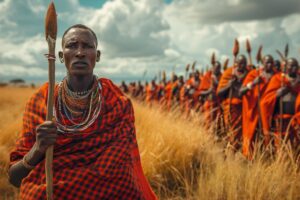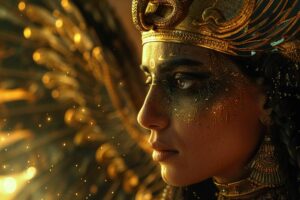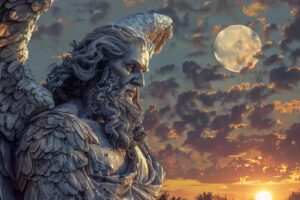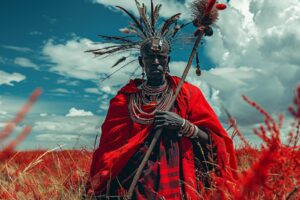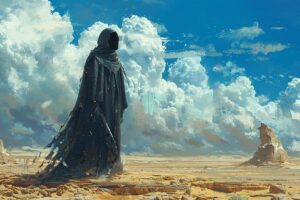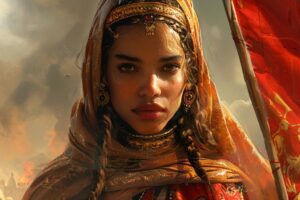Unveiling the Mysteries of Khoisan Mythology: Ancient Legends and Beliefs

Khoisan mythology encompasses ancient creation myths, illustrating the role of Kaang as the creator of the world and the chaos unleashed by fire. Seeking restoration, humans and animals sought intervention from Kaang, who established strict laws and taught values such as respect and cooperation.
The creation of the Via Lactea by a girl and the random distribution of body parts among species further highlight Khoisan cosmology. Death is viewed differently for animals and humans, with shamans playing a significant role in communicating with spirits.
Khoisan religion involves healing dances, trance states, and expressing gratitude through worship. This article explores the rich heritage of Khoisan myths and stories.
The Creation Myths of the Khoisan
The mythology of the Khoisan people is rich with creation myths that offer insights into the origin of the world and its inhabitants. These myths provide a glimpse into the beliefs and values held by the Khoisan community.
The Role of Kaang, the Creator of the World
In Khoisan mythology, Kaang is revered as the creator of the world. Kaang holds significant importance as the divine being who shaped the universe and all living beings within it. As the central figure in the creation narratives, Kaang’s role is essential in understanding the beginning of existence according to the Khoisan tradition.
The Chaos and Destruction Unleashed by Fire
One of the prominent elements in Khoisan mythology is the chaos and destruction that ensued when fire was introduced by humans. The use of fire, intended to provide warmth, unintentionally led to conflicts and battles among animals.
The resulting mayhem disrupted the harmony that once prevailed, plunging the world into turmoil and danger.
Seeking Restoration and Intervention from Kaang
In the midst of the chaos, the Khoisan people realized the necessity of seeking Kaang’s intervention to restore peace and order. Animals were called upon to approach Kaang and implore for their creator’s return.
Their collective supplications moved Kaang, prompting the decision to give humanity a second chance.
Kaang returned to the world, establishing strict laws and imparting values such as respect and cooperation to the human population.
Recognizing the dangers associated with fire, Kaang reiterated the lessons of the past, guiding humans towards a harmonious coexistence with animals and nature.
The creation myths of the Khoisan shed light on the fundamental aspects of their cosmology and provide insights into their worldview.
These narratives exemplify the significance of the divine creator, the consequences of human actions, and the eternal quest for harmony and balance within the Khoisan community.
Harmony and Coexistence with Animals
Khoisan mythology emphasizes the importance of harmony and coexistence between humans and animals.
Under Kaang’s guidance, strict laws were established to govern human behavior and ensure respect for all living beings. These laws served as a reminder of the consequences unleashed by the chaos caused by fire.
Kaang taught values such as respect and cooperation, emphasizing the need to live in balance with nature.
Establishment of Strict Laws by Kaang
Kaang, the creator of the world, returned to restore order and harmony. Recognizing the destructive nature of unchecked behavior, Kaang established strict laws for humans to follow. These laws governed all aspects of human life, including their interactions with animals and the natural world.
The laws served as guidelines for behavior, promoting a sense of responsibility and mutual respect.
Values Taught by Kaang: Respect and Cooperation
Through his teachings, Kaang emphasized the values of respect and cooperation. Humans were instructed to treat animals with reverence, recognizing their significance in the ecosystem. Cooperation was encouraged through the understanding that a harmonious coexistence would benefit both humans and animals.
This shared sense of respect and cooperation fostered a mutual understanding and appreciation between the two realms.
Living in Balance with Nature
To restore harmony with nature, Kaang reminded humans of the importance of living in balance with their surroundings. This involved sustainable practices, recognizing the interconnectedness of all living beings. Humans learned to honor the natural world by not only taking what they needed but also contributing to the overall well-being of the ecosystem.
By embracing a lifestyle that respected and preserved nature, humans sought to maintain a harmonious coexistence with animals and the environment.
The Creation of the Vía Láctea
The Khoisan mythology includes the captivating story of the creation of the Vía Láctea, also known as the Milky Way. This mesmerizing tale has been passed down through generations, carrying the essence of wonder and awe.
The Myth of the Girl and the Sparkling Embers
According to Khoisan mythology, the creation of the Vía Láctea can be traced back to a young girl who wielded the power of sparkling embers. Entranced by the flickering beauty of the tiny flames, the girl flung them into the night sky, unaware of the cosmic masterpiece she was crafting.
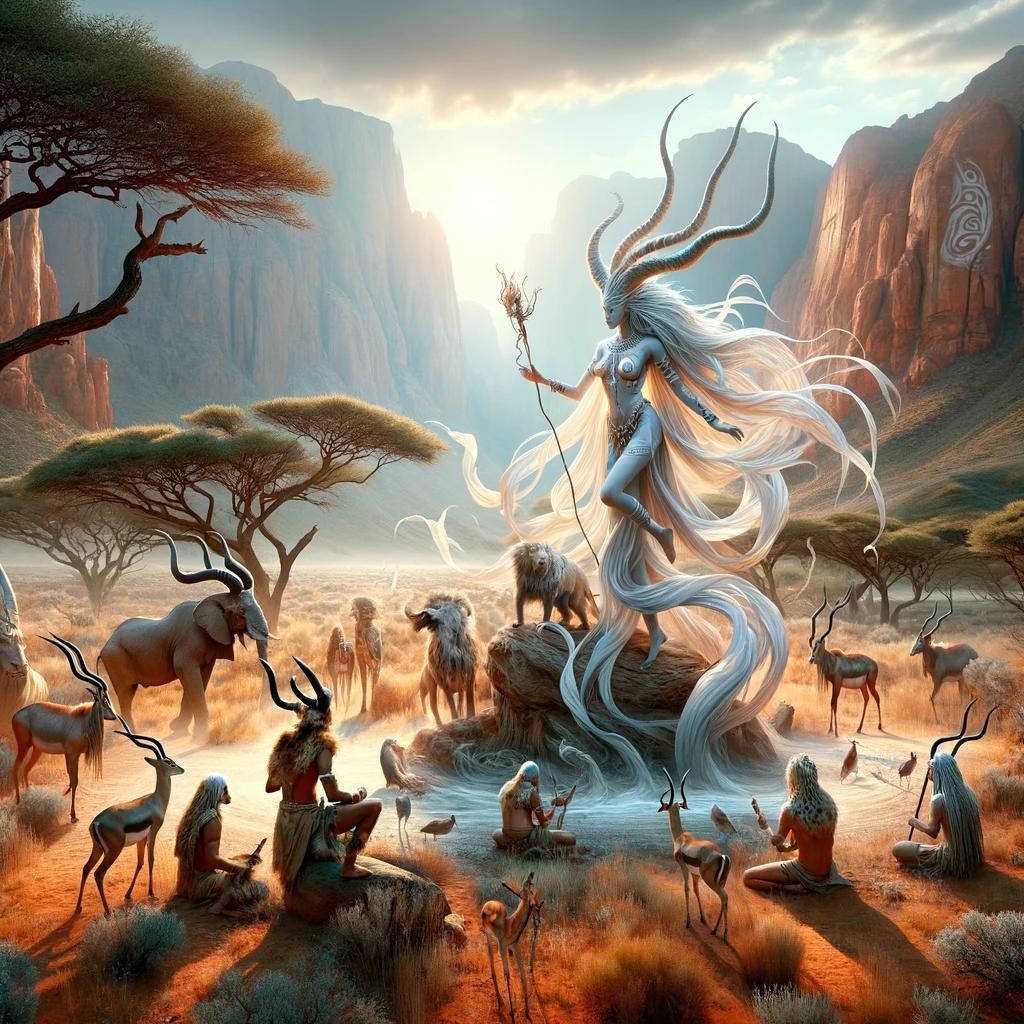
Transgenerational Transmission of the Vía Láctea Story
Over time, the myth of the girl and the sparkling embers became an integral part of Khoisan folklore. It was shared from one generation to another, ensuring the preservation of this enchanting narrative.
The Vía Láctea came to symbolize the girl’s eternal connection with the celestial realms.
As the Vía Láctea stretches across the sky, its shimmering light serves as a reminder of the Khoisan’s rich cultural heritage.
This mesmerizing tale sparks curiosity and invites us to marvel at the wonders of the cosmos, connecting us to the ancient traditions of the Khoisan people.
Cosmology and the Distribution of Species
The cosmology of Khoisan mythology revolves around the initial confusion and mixing of species.
In the beginning, all species were intertwined and indistinguishable from one another. It was the creator, Kaang, who intervened and randomly distributed body parts among the different animals, giving each species its unique identity.
Initial Confusion and Mixing of Species
At the start of time, there was a lack of order and differentiation among the various species. Animals and humans coexisted without defined characteristics, leading to a state of chaos and disarray.
Kaang saw the need for organization and separation, which ultimately paved the way for the diversity of species we see today.
Random Distribution of Body Parts by the Creator
Kaang took the responsibility of distributing body parts among the animals, ensuring that each species had its unique physical attributes. This random allocation resulted in the various forms and structures we observe in different animals, highlighting the intricate design created by Kaang.
Evolution of Species and Adaptation to Environments
As species evolved, they adapted to their respective environments and acquired traits necessary for survival. The distribution of body parts by Kaang played a crucial role in facilitating this adaptation. Each species assumed the identity suggested by its name and found its rightful place in the natural world, thriving in specific habitats and consuming appropriate food sources.
- Kaang’s intervention led to the remarkable diversity of species we witness today.
- The random distribution of body parts contributed to the unique characteristics of each animal.
- Species evolved and adapted, finding their niche in the complex balance of nature.
Duality of Life and Death in Khoisan Cosmology
The Khoisan cosmology encompasses a unique understanding of the duality between life and death.
It distinguishes between the death of animals and humans, as well as their respective roles in the social order and the spiritual realm.
Death as Part of Animal Existence and Nourishment
In Khoisan belief, the death of animals is seen as an inherent part of their existence and serves as a means of nourishment.
Animals are revered as a source of sustenance for humans, and their death is seen as a necessary cycle to maintain balance in the natural world.
Human Death and the Role of the World’s Administrator
On the other hand, human death in Khoisan cosmology is attributed to the role of the world’s administrator.
This figure is believed to consume the deceased and keep their spirits within, perpetuating the social order from which they originated. The administrator’s involvement in human death underscores the significance of maintaining harmony and order in the Khoisan worldview.
Perpetuating Social Order Through Spirit Connection
Within Khoisan cosmology, the spirits of the deceased are considered to have a vested interest in death, as they seek to perpetuate the social order. Through connections with these ancestral spirits, individuals can seek guidance, wisdom, and healing.
The spirit connection serves as a means to uphold and strengthen the fabric of Khoisan society.
Role of Khoisan Shamans
The Khoisan shamans play a significant role in Khoisan cosmology and religious practices. They possess unique abilities to communicate with spirits and embark on astral journeys, gaining profound knowledge and acquiring special powers in the process.
Communicating with Spirits and Astral Travel
Through their exceptional spiritual connection, Khoisan shamans engage in direct communication with ancestral spirits and otherworldly entities. They enter altered states of consciousness and embark on astral travels, exploring realms beyond the physical world.
Acquiring Knowledge and Special Powers
During their interactions with spirits, Khoisan shamans obtain invaluable knowledge about the natural and supernatural realms. They acquire unique powers, such as divination, healing abilities, and the capacity to influence the forces of nature.
Controlling the Natural World
Khoisan shamans, with their acquired powers, are believed to have the ability to control and manipulate aspects of the natural world. They can communicate with animals, call upon the elements, and ensure the harmony between humanity and nature, acting as intermediaries between the physical and spiritual realms.
Rituals and Trances in Khoisan Religion
The Khoisan people have a rich tradition of rituals and trances that play a significant role in their religious practices. These rituals serve as a means of healing, communication with ancestors, and expressing gratitude through worship and blessings.
Healing Dances of the San People
Among the Khoisan, the San people are particularly known for their healing dances. During these dances, individuals enter a trance state and establish a connection with the spiritual realm. It is believed that the rhythmic movements and the guiding music of drums and rattles help the dancers achieve a deep meditative state.
The women of the San community wear special attire and jewelry that are believed to possess spiritual powers. Through these dances, they seek to connect with the spirits of their ancestors, seeking guidance and healing.
The healing dances are not only physical but also spiritual, aiming to restore balance and well-being.
Trance States and Communication with Ancestors
Trance states are an integral part of Khoisan religious practices as they enable communication with ancestors. Through deep meditation and altered states of consciousness, individuals are believed to establish a connection with the spiritual realm, where they can receive guidance and wisdom from their ancestors.
During trance states, individuals may experience visions, receive messages, or undergo physical and emotional transformations. This communication with ancestors is highly regarded and respected within Khoisan cosmology, as it is seen as a way to uphold cultural traditions and honor their lineage.
Expressing Gratitude through Worship and Blessings
Expressing gratitude is an essential aspect of Khoisan religious practices. Through worship and blessings, individuals show appreciation for the blessings received from the divine. This can take various forms, including prayers, rituals, and offerings.
By expressing gratitude, the Khoisan seek to maintain a harmonious relationship with the spiritual world and acknowledge the interconnectedness between humans, nature, and the divine. Worship and blessings are seen as a way to honor and reciprocate the blessings and abundance bestowed upon them.
In conclusion, rituals and trances hold immense significance in Khoisan religious practices. The healing dances of the San people, trance states for communication with ancestors, and expressing gratitude through worship and blessings are integral parts of the Khoisan religious and cultural identity.
In delving into the rich tapestry of Khoisan mythology, we are granted a unique glimpse into a world where ancient legends and beliefs intertwine. The significance of Khoisan mythology lies not only in its mesmerizing stories but also in its ability to imbue profound teachings and lessons.
Unveiling the Mysteries: Profound Teachings and Lessons
- The Creation Myths of the Khoisan shed light on the role of Kaang as the creator and the chaos caused by the ill-fated act of igniting fire.
- Through seeking restoration and intervention from Kaang, the Khoisan recognized the value of harmony, respect, and cooperation, as taught by Kaang.
- In living in balance with nature, the Khoisan found solace and sustainable coexistence with animals, honoring the interconnectedness of all living beings.
- The creation of the Vía Láctea, a mesmerizing tale passed down through generations, serves as a reminder of the cultural heritage and timeless wonders encapsulated in Khoisan mythology.
The Cultural Tapestry: Appreciation for Khoisan Diversity
Khoisan mythology provides a window into the vibrant cultural heritage of the Khoisan people.
It highlights the diversity and deep-rooted traditions that contribute to their unique identity. The tales of the creation and the distribution of species unveil the cultural tapestry woven by the Khoisan, honoring the wisdom and resilience of their ancestors.
As we reflect on the significance of Khoisan mythology, we are invited to appreciate the profound teachings and diverse cultural heritage that this remarkable body of folklore offers. It serves as a testament to the depth and richness of the Khoisan people’s beliefs, fostering a deeper understanding of their worldview and the intrinsic connection between humans, animals, and the natural world.
Conclusion
The exploration of Khoisan mythology in this article has highlighted the essential role it plays in shaping the cultural fabric and worldview of the Khoisan people. From creation myths to the appreciation of cultural diversity, Khoisan mythology offers invaluable insights into the interplay between humans, nature, and the spiritual realm.
It is through understanding and appreciating this mythology that we can deepen our appreciation for the intricate tapestry of human existence.
Further Exploration of Khoisan Myths and Stories
In delving deeper into Khoisan mythology, we uncover a rich tapestry of captivating stories and legends that have been passed down through generations. These myths offer profound insights into the beliefs, values, and cultural heritage of the Khoisan people.
Let us embark on a journey of discovery as we explore some of the significant myths and stories that have shaped the Khoisan worldview.
The Power of Oral Tradition
At the heart of Khoisan mythology lies the power of oral tradition. Through the art of storytelling, myths and legends have been preserved and transmitted across time, ensuring the continuity of Khoisan cultural heritage.
We will explore how these narratives have shaped the Khoisan understanding of creation, nature, and the spiritual realm.
Myths of Creation and the Role of Kaang
The creation myths of the Khoisan offer profound insights into their cosmology. We will delve into the stories surrounding Kaang, the creator of the world, and the pivotal role he plays in establishing order and harmony.
Through these myths, we gain a deeper understanding of the Khoisan’s reverence for the natural world.
Animal Symbolism and the Natural Order
Khoisan myths often incorporate animal symbolism, reflecting the profound connection between humans and the animal kingdom. We will explore the significance of these symbols and how they contribute to the Khoisan understanding of the natural order.
Through these stories, we gain insights into the Khoisan’s approach to coexistence and respect for all living beings.
Journeys to the Spirit Realm
Shamans play a crucial role in Khoisan mythology as mediators between the human and spirit realms. We will explore their practices and rituals that involve trance states, astral travel, and communication with ancestors.
Through these journeys, shamans acquire knowledge and insights that guide their communities and foster a deeper connection with the spiritual realm.
The Significance of Rituals and Ceremonies
Rituals and ceremonies hold a profound place in Khoisan mythology, serving as expressions of gratitude, healing, and connection with the divine. We will explore the various rituals, including healing dances and worship practices, that play a vital role in the Khoisan spiritual experience.
Through these rituals, the Khoisan maintain a harmonious relationship with their ancestral spirits and the natural world.
By delving into these captivating myths and stories, we gain a deeper appreciation for the complex belief systems and cultural heritage of the Khoisan people.
Their mythology serves as a testament to the enduring power of storytelling and the profound connection they maintain with their ancestral traditions even in the modern age of 2023.
.













